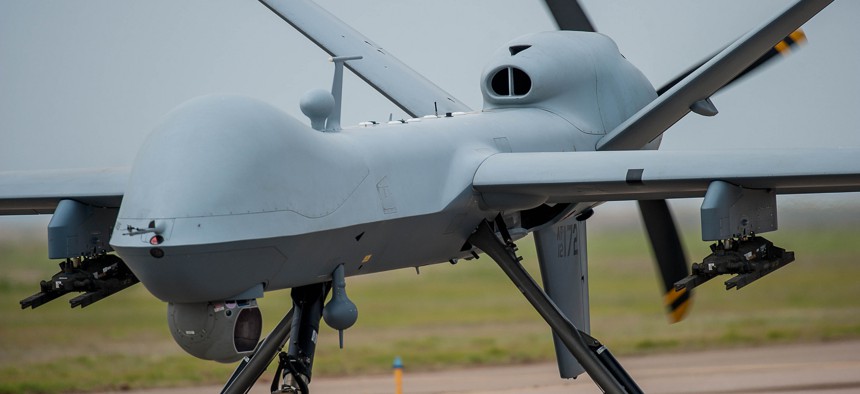
MQ-9 Reaper U.S. Air Force
Drone Strikes Expand, Hustling the US Down a Risky Path
It’s time to rethink the tradeoffs between tactical efficiency and strategic risk. A new Stimson Center report lays them out.
More than 16 years after the first U.S. drone strike, the armed unmanned aerial vehicle remains key to American counterterrorism operations, and the Trump administration is expanding their use. But the weapon has long presented lawmakers, other U.S. leaders, and even our allies with problems of transparency, oversight, and strategy. Now, as administration officials roll back measures installed by their predecessors to deal with some of these issues, it is time to take a broad look at drones’ place in national security — and how best to use them.
The Trump administration is dialing up the frequency and global scope of drone strikes, has allowed military operators to have greater strike-decision authority, and expanded the CIA’s role and responsibilities in lethal strike operations. Each of these changes is occurring under a veil of secrecy, compounding challenges to legitimate and responsible use of armed drones that supports broader U.S. objectives.
This approach to drone policy holds considerable risks, particularly as drones proliferate around the world. The reality is that the United States does not maintain a monopoly on the use of armed drones in conflicts, nor do states, alone, retain a monopoly on the use of this technology. In developing its own practice for conducting lethal drone operations, the United States is setting a de facto international standard for transparency and accountability regarding drone use, even though such a standard may run counter to global norms for use. In short, U.S. policy and practice affects not only what is happening within and to the United States, but how our allies, partners, and even our enemies use drones for their own purposes.
To highlight some of these issues and offer insights on ways to improve the U.S. drone program, I worked with a study group of 11 experts over the past year to examine current U.S. policies and practices — as established during the Obama administration and adapted and revised under the Trump administration. The result, An Action Plan on U.S. Drone Policy, provides a roadmap for the Trump administration to develop, implement, and sustain a comprehensive U.S. drone policy that reduces risks and reflects appropriate and legitimate use of lethal force to achieve U.S. strategic objectives.
Our recommendations include practical and tangible ways the administration can support the development of a comprehensive policy on armed drones. For example, the administration should publicly release any new policies, principles, standards, or procedures that govern the U.S. drone program. The administration should also undertake a strategic assessment of the efficacy and long-term impacts of the U.S. drone program, as well as acknowledge and address civilian casualties resulting from drone strikes and uphold international human rights law and international humanitarian law through the continuation of written assurances on use from U.S. drone export recipients. Congress has a role to play as well in ensuring effective oversight and requesting greater transparency over program costs and effects.
The United States has an opportunity to be a leader on establishing appropriate standards for drone use and developing an effective, transparent, and accountable policy that reflects oversight from appropriate stakeholders. Such an approach will lend credibility and legitimacy to, and reliability of, the U.S. drone program. Moreover, a U.S. drone policy that values human rights, the rule of law, and good governance, and protects U.S. national interests, is consistent with and furthers U.S. values and principles.
NEXT STORY: How Sanctions Feed Authoritarianism


